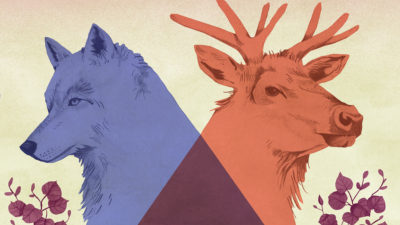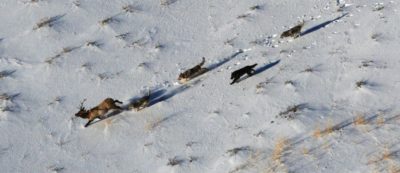On a beach in the Gulf Islands off the coast of southern British Columbia, biologist Liana Zanette lashed speakers to a tree for a special broadcast. It wasn’t music, and it wasn’t played for people. It was the sharp sound of barking dogs — aimed at a population of bold raccoons.
Instead of being nocturnal, as raccoons usually are, these animals had also grown accustomed to feeding during the day. Wandering away from the security of forests, they traveled far out onto the exposed tidal flats to look for worms, clams, and other food, unconcerned about being eaten because predators in the area are rare. Bears and wolves had long been extirpated. Only the occasional dog brought there by locals threatened their utopia.
So for two months, Zanette blasted out two sounds — barking dogs, and, as a control, barking seals and sea lions, which posed no predation threat.
The effort to restore a semblance of fear to this raccoon nirvana enjoyed marked success. As Zanette reported in a paper in Nature Communications, the raccoons spent two-thirds less time feeding in the tidal zones when the electronic dogs barked, which resulted in 81 percent more fish being found in the pools and some 60 percent more worms and red rock crabs. “It’s a massive effect,” says Zanette, a biologist at Western University in Ontario.
Welcome to the ecology of fear. Many biologists think that the terror felt by prey creates a major — and greatly under-appreciated — behavioral dynamic that ripples through all kinds of ecosystems. In fact, it likely has more impact on an ecosystem than the actual predation itself, because one snarling predator can change the feeding behavior of many individuals without killing them.
“All animals, no matter what taxa, need to worry about predators,” says Zanette. “Even tigers worry about humans. So it’s a really strong evolutionary force.”
Because it’s hard to separate from other elements, though, the fear factor has been difficult to study and so isn’t accounted for in ecological models. That’s changing.
The 1995 reintroduction of wolves to Yellowstone National Park led to seminal research on the ecology of fear, with the wolves altering the feeding behavior of elk and touching off a cascade of ecological effects on vegetation and other wildlife. In recent years, researchers like Zanette have developed new approaches in hopes of creating a deeper and more nuanced understanding of the role of fear, given how important it is to understanding ecosystems. Yellowstone, meanwhile, continues to provide new insights into the ecology of fear on a large, wild landscape.
Fear of wolves altered the feeding behavior of elk in Yellowstone, with important implications for the ecosystem.
The topic raises important conservation questions. As predators have declined globally, their disappearance — and the fear factor they induce in prey — has had knock-on effects in numerous ecosystems. Can a decline in biodiversity brought about by a lack of predators be restored by bringing them back?
“It underscores the importance of protecting intact populations of predators,” says Larry Dill, an emeritus professor of biology at Simon Fraser University who studied similar dynamics in marine ecosystems. “Without healthy populations of wolves and sharks you have impacts all the way down the food chain.”
Among the first studies of the role of fear were small-scale efforts in controlled environments with spiders and grasshoppers in the 1980s. Oswald Schmitz of the Yale School of Forestry & Environmental Studies watched as grasshoppers foraged inside screen cages, both with and without predatory spiders present. When the spiders were absent, he noticed the hoppers foraged on grass; when the spiders were returned to the cages, the grasshoppers switched to feed on forbs — taller flowering plants that offered the grasshoppers both food and a place to hide.
In a later experiment, Schmitz created what he called “risk spiders.” These were predatory spiders, but with their mouth parts glued shut so they still appeared to present a risk to the grasshopper, but couldn’t actually prey on them. And even though the spiders had been de-fanged, the hoppers still fled to the forbs, showing, Schmitz concluded, that the mere presence of predators — and the fear they engender — affected the plant-eating behavior of the prey and changed ecosystem dynamics.
That, however, was on a very small scale in the lab. The ecology of fear gained prominence in the 2000s when Yellowstone researchers noticed that willows and aspen had regrown in some places following the return of wolves. The wolf, an apex predator, killed so many of the park’s elk, experts said, that it caused profound adjustments to the ecosystem — something known as a trophic cascade. But fear also significantly altered the feeding of the surviving elk, with important implications for the Yellowstone ecosystem.
The steep drop in elk populations — from roughly 20,000 before the wolf reintroduction to 6,000 today — meant that the ungulates were mowing down fewer of the park’s young willow and aspen trees. With willows, aspen, and grass more abundant, a range of other species, from beaver to songbirds, benefited from the expansion of their prime habitat. More beaver ponds meant higher water tables, more stabilized stream flows, and more and better fish habitat.
Wolves chase an elk in Yellowstone National Park. Rebecca Raymond, Yellowstone Wolf Project/National Park Service
But some studies showed that the fear of predation also had a profound impact on the ecosystem. When the wolves showed up, the elk suddenly snapped to attention. They had to be extremely vigilant, ecologists said, and could no longer hang out carefree by the river eating riparian plants to their heart’s content.
That meant grazing intensity and patterns shifted. With elk no longer feeling secure as they browsed in the river bottoms, willow and aspen trees grew tall again for the first time in decades. One 2010 paper on this new psychological terrain of Yellowstone was titled “The Landscape of Fear: The Ecological Implications of Being Afraid.”
Given that the wolf is a charismatic animal and Yellowstone National Park is world renowned, the “landscape of fear” became famous. A YouTube video narrated by Guardian columnist George Monbiot, for example, entitled How Wolves Change Rivers, has more than 35 million views — and vastly overstates the case, many scientists say.
Some critics say the notion of wolves restoring Yellowstone by dint of the terror they engender is a great story that has captured people’s imagination. But critics such as Oswald Schmitz are not convinced that these changes are linked to the reintroduction of wolves and the subsequent behavioral changes of elk. The growth of more willow and aspen, for example, could be accounted for by more flooding, which means more water for the streamside vegetation. But that possibility, some critics have said, hasn’t been factored into the studies. And Schmitz says there is good evidence that elk are not all that worried about the presence of wolves.
The debate over the ecology of fear ‘isn’t whether it’s true, but how it works,’ says one researcher.
Doug Smith, who has been the wolf biologist in Yellowstone park since the animals were brought back, disagrees with critics who dismiss the ecological impact created by the elks’ fear of wolves. While the fear effect “has been popularized beyond its real impact,” he told me when I visited the park recently, “there is a big pearl of truth to the trophic cascade” caused by the wolves’ presence.
In his opinion, “the debate now isn’t over whether it’s true, but how it works.” Disentangling factors such as fear from other impacts, such as bottomland flooding or the greatly reduced numbers of elk, is difficult, he says. But in a paper on the subject due out later this year, in which researchers tracked GPS-collared elk near wolves, he and colleagues found that “elk avoid risky habitat in willow stands during peak wolf activity. Fear of wolves shapes the landscape.” But precisely how is “a lot more complicated than we think.”
Such research could provide support for the protection of existing predator populations or a rationale to introduce new ones. Understanding the fear landscape may also offer new ways to manage ecosystems. Biologists conserving sage grouse in Oregon, for example, have found the ground-nesting birds avoid settling near juniper forests because ravens and raptors perch there and prey on the grouse. In many sage grouse nest sites, thousands of junipers have been cut down.
In the meantime, don’t look for predators to restore the broader natural world. The impact of wolves on a wild landscape like Yellowstone is one thing, but landscapes significantly changed by humans represent a much different question.
Meanwhile, another question beginning to be asked by researchers is what effect does the fear that humans engender in wildlife have on the natural world? A 2015 study called humans “super predators” because they kill carnivores at a whopping nine times the rate of other predators. Attuned to the steep risk posed by people, how do wolves, bears, wolverines, and bobcats change their behavior as a result of human presence, and how does that alter their role in the ecosystem?
No one knows, but Zanette has weighed in on this question as well. In the UK, badgers — which love worms and sometimes prey on birds, animals, and reptiles — have had only one primary predator for centuries: humans. Zanette and her colleagues set out buckets of peanuts mixed with soil for the badgers. The scientists then played recordings first of sheep, and then of wolves, which are long gone from the ecosystem. Badgers ignored both in their feeding. Recordings of bears and dogs generated some delay in heading to the buckets. “But the thing they were most afraid of was people talking,” Zanette says. “We played BBC broadcasts, documentaries on aviation, actors reading books, and they generally did not come out of their hole while the humans were talking.”
Schmitz says the impacts of the presence of people — and the landscape of fear they create — could be substantial. “Humans,” he says, “can have important effects by scaring predators away, to the extent that ecosystems’ processes could fundamentally change.”




